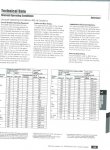Chamblee
Member
- Location
- Birmingham, Alabama, United States
I am bidding some work where I will be feed some 400A 400Hz distribution panels and some 100A 400Hz sub-panels I am confused as to what type and size of wire I should be using for this installation. This is design build work so I do not have an engineered set of drawings I only have concept drawings. I have some spec sheets on 400Hz cable sent to me from my supplier however I am unsure as to what I need because the spec sheets do not show ampacity.
Does anyone know this information and where I can find it in the code book.
Does anyone know this information and where I can find it in the code book.

